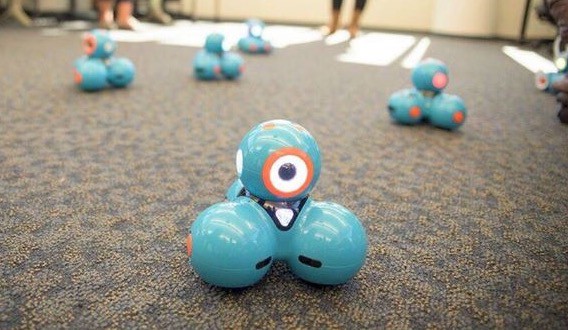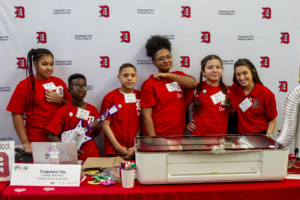How Robotics is Transforming STEM in Elementary Schools

By: June Lin
Julia Dweck’s classroom in Macungie, PA looks more like a production studio than your typical elementary school. Students from different grade levels are working together in small groups, scribbling angles and math formulas on the whiteboard, writing a storyboard script for a video, cutting out colorful construction paper figures, and creating code on their iPad for a robot named Dash. There are occasional heated debates and shenanigans, but they are all laser focused on solving challenges in the Wonder League Robotics Competition.
STEM education is top of mind as high-paying jobs in STEM fields are growing with an inadequate pipeline of American students to fill them. In the Every Student Succeeds Act, President Obama’s goal is to train 100,000 STEM teachers over the next 10 years. Many of the efforts are directed towards middle school and high school, but research shows that introducing STEM early plays a key role in cognitive development and interest in the subjects later on. Much of math and science instruction in schools is theoretical, and elementary school teachers are paving the way to look for engaging ways to bring STEM to life in their classrooms.
Robotics in the classroom
In elementary school, students are still learning with their eyes and hands – drawing, molding, and manipulating objects. They are starting the tough transition to learning by reading, and robots make it possible for them to work through problems visually and experiment with concepts they are learning.
Ms. Dweck’s students have designed mazes, produced geometric shapes, calculated perimeter, tested probability, composed music, recorded dialogue, and even retraced the voyage of the Mayflower with Dash. As Ms. Dweck says, “‘Millennials’ have been raised on technology. They have no fear of it and are eager to jump right in and create. They are natural innovators who relish and need this creative platform.”
Many of these pioneering teachers who focus on inquiry-based learning try to integrate robotics into as many subject areas as possible. Making these curricular connections also allows them to justify teaching computer science, a subject that is currently required in only a handful of regions.
Robotics competitions
As an organization we, Wonder Workshop, decided to start a national robotics competition because we were seeing a wide range of implementations of robotics in the classroom. Some teachers used Dash as “reward time” for good behavior without much instruction, while others used Dash to support their math lessons. We were seeing that project-based activities were the most successful in engaging students across the board.
In developing the Wonder League Robotics Competition, we wanted to create a more in-depth and structured version of the Hour of Code with a focus on educating the whole child. Students deeply engaged in robotics and coding, worked in teams, and integrated their creativity. We also created a forum where teachers could learn from one another. It was important for our competition missions to tie back to real-world applications – in this case, space exploration.
There are many types of STEM competitions, mostly targeted at middle and high school students. The VEX IQ Challenge is a competition for 3rd grade and up, and FIRST LEGO League Jr. is non-competitive event that gets kids ages 6-9 geared up for FIRST LEGO League. They positioned robotics as a “team sport for the mind” and have been successful in developing excitement for robotics and building teamwork skills. We also saw similar results from the Wonder League Robotics Competition. Many students were coming into the classroom after school and during recess to work with their teams, and some students even put aside other sports and activities to be part of it.
Students in 3rd, 4th & 5th grade collaborate on a team name for our @WonderWorkshop robotics team. #wonderleague pic.twitter.com/hd0N21pJ5Y
— Mrs. Dweck (@GiftedTawk) October 25, 2015
“I learned to always include all of my teammates because it isn’t fair if nobody else gets a chance to do things and we can finish anything on time if we just work together,” says one 8-year-old student on the Wonder Dash team that recently finished 3rd place in the nation. Surprisingly, many of the top contenders came from small towns that don’t necessarily have access to the resources that spill over from having a strong technology-based economy.
Tips for teachers
For teachers who are looking for ways to integrate robotics into the classroom, we’d love to share some tips.
- Pick the right platform for you. Some robotics kits require many hours of building to get started, and others work right out of the box. In developing Dash & Dot, we prioritized ease-of use-and created different apps that work for different interests from kindergarten to even middle school. Make sure to do your research before investing.
- Make use of existing content. Developing your own lessons from scratch can be intimidating and impractical. Use content that’s available in apps or lesson plans that other teachers have created.
- Join the community on Twitter. There is a rich network of teachers who are actively helping each other out on Twitter. Some hashtags to follow are #csk8, #kidscancode, and #wonderleague.
- Don’t be afraid to let the students lead. Ms. Dweck says that after introducing the robots, they’ve “gotten to a point where students are creatively designing their own projects that integrate Dash, Dot and accessories in ways that achieve goals across subject areas.” It takes the pressure off you and helps lead to growth mindset if students can take charge of their own learning.
“This opportunity helps students develop a respect for their own abilities. As students develop strategies to facilitate the learning process, they experienced growth in their meta-cognitive skills, too. Introduction to coding and robotics is as relevant to our world as learning to write. Today’s learner should experience opportunities to practice coding and robotics in the classroom from an early age. This foundation will serve them as learners, digital citizens and world leaders,” Ms. Dweck remarks.
For more, check out:
- RAMTEC: Robotics, A Path to Employment & Economic Development
- Girls Who Code: Connecting GenDIY Women to STEM
- Robots & Implications For Life On Planet Earth
June Lin is the Head of Community and Education at Wonder Workshop. Follow June on Twitter, @junelin.
Stay in-the-know with all things EdTech and innovations in learning by signing up to receive the weekly Smart Update. This post includes mentions of a Getting Smart partner. For a full list of partners, affiliate organizations and all other disclosures please see our Partner page.







John Wilkerson
Great thoughts here. As a homeschooler, robotics has transformed how we educate our kids. My kids from 7 to 16 use Dash and Dot and it helped them when they joined a FIRST LEGO League team.
Eric
I am looking to introduce robotics and coding to my 6th grade students. We have Chromebooks to use in the classroom but I'm struggling to find a robotic to use. We have done an hour of code on KhanAcademy earlier this year so they have some background. Thanks
androidrobo
As advancements to how we approach STEM education and initiatives are on the rise around science, engineering and mathematics, we’re seeing a greater impact on how we recognize children’s development and understanding of now-vital tech skills, robotics will continue to play an important role.